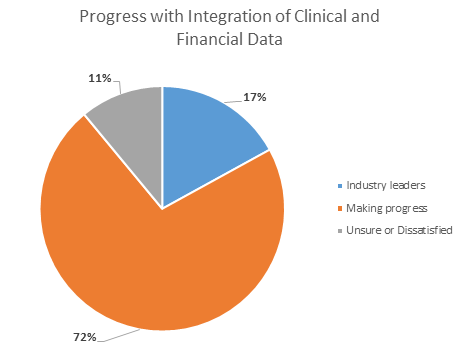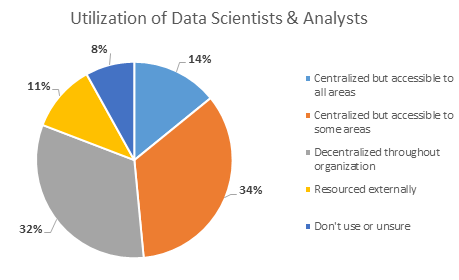In my previous post, I wrote about the Quick Pulse survey of leaders of health care institutions and the vital role data and analytics has in patient care and engagement. In this post, I'll tell you what the survey had to say about the progress these leaders believe they are making in integrating data and analytics into their organizations.
When asked whether they consider their own organizations to be industry leaders in integrating clinical and financial data, 17 percent of survey respondents indicated agreement. However, 72 percent perceive their organizations to be growing significantly and making progress with the integration of clinical and financial data. This is encouraging news and conveys a sense of optimism and progress in achieving the data and analytics objectives.
Using data scientists and analysts
Finally, survey respondents indicated that only 15 percent of health care organizations employ data scientists that are centralized and accessible to all areas of the organization. In most cases, access is limited to specific areas or locations.
Key takeaways
This survey helps confirm general observations across the U.S. health care industry that most hospital-based organizations are in the process of retooling to get better at using data for making real-world decisions. They are actively looking for ways to minimize data siloes, provide actionable data at the point of service and learning to work together across their organizations to encourage data-driven performance improvement.
This means that if:
- Your hospital or care delivery system is actively implementing data governance and a unified analytics capability, rest assured that you are not a bunch of geeks. Your leaders are getting it and you need to support those efforts.
- If your organization is not doing this, you may want to think hard about your ability to effectively deal with the emerging environment of value-based care. Remember: If you can’t measure it, you can’t manage it.
- Make sure you are building a culture that uses data to drive clinical and operational decisions. This is not just for researchers – we have to work smarter in health care.
- Make it a priority to develop citizen data scientists or more simply, help your clinicians and business professionals get comfortable working with data and simple statistical test, then using the results to make decisions. You don’t need to turn them into statisticians or programmers, just teach them fundamentals and help them develop a healthy respect for information-driven practice.
To that end, SAS is the ideal partner. No other organization excels in data management, enabling front-line data exploration and providing flexibility in being able to customize and share visualizations of what the data are communicating, in order to create real solutions. Now that's a toolkit for real progress!
Interested in learning more about how health care and life sciences organization use SAS analytics? Tune into our free, on-demand virtual forum in which industry experts share their strategies, best practices and challenges.


